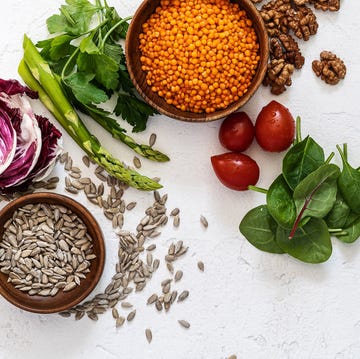You’ve heard of ‘five a day’ as a target for fruit and vegetable intake, but now it’s all about eating 30 different plant-based foods each week. The recommendation comes from the American Gut Project, which compared the gut microbiota (the bacteria that lives in the gut) of more than 10,000 people from across the world.
The results showed that a plant-based diet plays a huge role in gut health, with an increased diversity of plant types in a person’s diet leading to increased diversity in their gut microbiome. What was crystal clear was that those who consumed more than 30 different plant foods a week had better gut health than those who ate fewer than 10.
As we’re all becoming increasingly aware, gut health matters. As much as 70% of your immune system lives there – it’s linked to how your metabolism, brain and body function, and even your mental wellbeing – so a healthy gut can lead to healthier body and mind.
What to read next
What counts?
‘In simple terms, plant foods are any foods that originate from plants, and includes all parts of a plant – their roots, leaves, fruits, seeds and stems,’ explains Catherine Rabess, registered dietitian and author of The 30 Plan (Headline Home). ‘It’s easiest to think of them in six categories: fruits; vegetables; wholegrains; pulses; nuts and seeds; and herbs and spices. Including foods from each category increases plant diversity, which is key to optimising gut health.’
In a ‘plant points’ system popularised by Dr Megan Rossi, founder of The Gut Health Doctor, each different variety of plant that you eat counts as one point. Herbs and spices are a quarter of a point each. So, if you ate a banana, an apple and a carrot, you would have earned three plant points. If you had porridge and sprinkled on cinnamon and nutmeg, the added spices would total half a plant point. The more plant points you earn, the more diverse your diet is and the better your gut health is likely to be.
These plant points come in a rainbow of colours and flavours, and our gut microbes thrive on them, using them as their own source of nourishment. In return, they help to keep your gut environment balanced and healthy. ‘Plant points are based on phytochemicals, plant chemicals that provide a wide range of health benefits and are like secret ingredients in a recipe for good health,’ explains Catherine.
The key thing you need to know? Portion size doesn’t really matter – it’s all about variety. So, you don’t need scales, weights, or measurements, or to eat a whole fruit or vegetable, for instance – you just want to try to get more diversity in your diet. Also, foods do not always need to be fresh. Tinned and frozen count, too – these are often cost-effective and help limit waste.
Fabulous fibre
Why can eating 30 plants revolutionise your gut health? Much of it is to do with fibre. Essentially, if you are upping your plant points, you will naturally be increasing your intake of all types of fibre. ‘Having lots of fibre and plant diversity in your diet helps to nourish good microorganisms and keeps the gut stable and thriving,’ says Catherine. ‘The more diverse the gut microbiota (the trillions of microorganisms that live in the gut), the better your health and overall wellbeing.’ Plant foods are also rich in polyphenols – protective plant chemicals – which have incredible powers and are sometimes described as the bodyguards of the gut. Bacteria
in our gut break down polyphenols into smaller compounds, which boost microbial diversity and benefit our health in many ways. A diet rich in polyphenols may offer protection against development of certain cancers, cardiovascular diseases, type 2 diabetes and neurodegenerative diseases.
More is more when it comes to colour, as it can be an indicator of polyphenol diversity. Dark and brightly coloured plants (think red, purple-blue, orange and yellow) indicate higher levels of these chemicals, says Catherine: ‘A red cabbage has three times the polyphenols of a white cabbage, and the darker the salad leaf, the higher its polyphenol content.’
She explains: ‘Having a colourful and diverse diet gives our bodies, but specifically our gut microbiomes, a boost of beneficial compounds. The more variety, the more diverse our microbial communities, supporting better digestion and immunity.’
Top tips
- Buy pre-mixed salad leaves and sprouted shoots for a no-effort accompaniment to your main meals.
- Stock up on frozen mixed vegetables or tinned options to help keep your plant points diverse.
- Choose mixed beans or buy different varieties each time you do a food shop.
- Opt for mixed seeds – they’re packed with lots of fibre to nourish the good gut microbes and are abundant sources of omega-3s, which reduce inflammation.
- Choose different colours and varieties of fruit or veg with each food shop to ensure you maximise your intake of polyphenols.
Breakfast
- If you like toast for breakfast, choose bread that contains multiple grains or seeds. Load it up with nut butter, banana, avocado, hummus or berry compote and you’ll get at least two points.
- Top your porridge (one point) with banana slices, mixed nuts and seeds, a spoonful of almond butter and a sprinkle of cinnamon and nutmeg and you’ll have around eight plant points.
- Add extra plant points to pancakes by making them with half wholemeal, half buckwheat flour.
- A breakfast smoothie made with frozen mixed berries, banana, oats, ground flaxseeds, nut butter and milk will give you around seven points.
- Make hash browns to pack in the veg. Add grated carrot, sweet potato, onions and tinned sweetcorn to the potato mixture and you’ll have five plant points.
- A bowl of granola with mixed nuts, mixed seeds, dried cranberries and apricots notches up around nine points. Add a sprinkle of cinnamon, ginger, ground cloves and nutmeg, and that’s an extra point.
Lunch
- Making lentil soup with onions, carrots, celery, garlic, brown or green lentils, plus a pinch of turmeric, cumin and paprika is a savvy way to boost plant points.
- Try GH’s baked beans recipe made with tinned mixed beans, onion and paprika (goodhousekeeping.com/uk/ food/baked-beans).
- Pre-cooked Puy lentils make a fibre-packed base for quick salads. Add wedges of cooked beetroot, tomatoes, mixed salad leaves and toasted nuts.
- Batch roast lots of colourful veg, then add them to wraps, salads or sandwiches, or freeze for future use.
- Spread sandwiches or toast with hummus instead of butter.
- A Buddha bowl made with tinned chickpeas, mixed leaves, pre-cooked mixed grains, hummus and a sprinkle of mixed seeds clocks up around 10 plant points.
- Add mushrooms, broccoli, spinach, courgette, tomato or red pepper to a frittata or omelette
Dinner
- If you’re making chilli con carne, add chickpeas, red kidney beans and cannellini beans for extra plant points.
- For Bolognese, replace some or all of the meat with green, brown or red lentils.
- Save time by using a frozen soffritto mix (carrot, celery and onion) as a base for soups, stews and sauces.
- Use packets of mixed stir-fry veg, choosing a different combo each time. Start your stir-fry with chopped onion, garlic and ginger, then add the stir-fry mix for extra plant points.
- Swap roasted potatoes for roasted mixed veg, such as butternut squash, sweet potatoes and parsnips.
- Try red lentil or chickpea pasta instead of regular pasta. These are rich in fibre and prebiotics as well as protein, vitamins and minerals.
- Swap half the lamb or pork mince in meatballs for tinned or pre-cooked Puy lentils: they’re higher in fibre and it’s an extra plant point, too.
- If you’re making curry or dhal, add extra veg, such as aubergine, cauliflower or frozen spinach.
Snacks
- As well as carrots, try green beans, sugar snap peas and radishes with dips.
- Create your own nut and seed blend or trail mix. Keep a jar of mixed nuts and milled seeds on your worktop to snack on or sprinkle over your meals.
- Fill Medjool dates with smooth peanut butter, dip into melted dark chocolate (at least 70% cocoa solids), then into ground pistachios and flaxseeds.
- Add blueberries and mixed seeds to flapjacks for extra plant points.
- Swap crisps for nuts or seeds; or roast chickpeas in the oven with olive oil, garlic powder, paprika, cumin and black pepper.
Plant points: how they add up
- Extra virgin olive oil, dark chocolate (at least 70% cocoa solids), tea and coffee count as a quarter of a point, as do individual herbs and spices.
- Remember that fresh, dried, frozen and tinned fruit and vegetables all count as plant points, too.
- Different colours get you 1 point per colour. A green apple and a red apple are 2 points; a red and a yellow pepper are 2 points
- Each different variety of plant equals 1 point. So, if you add kidney beans and butter beans to a stew or salad, that will equate to 2 plant point
- Refined foods, such as fruit juices, white bread and rice, don’t count, so stick with whole foods as much as possible – for example, choose brown instead of white rice.














